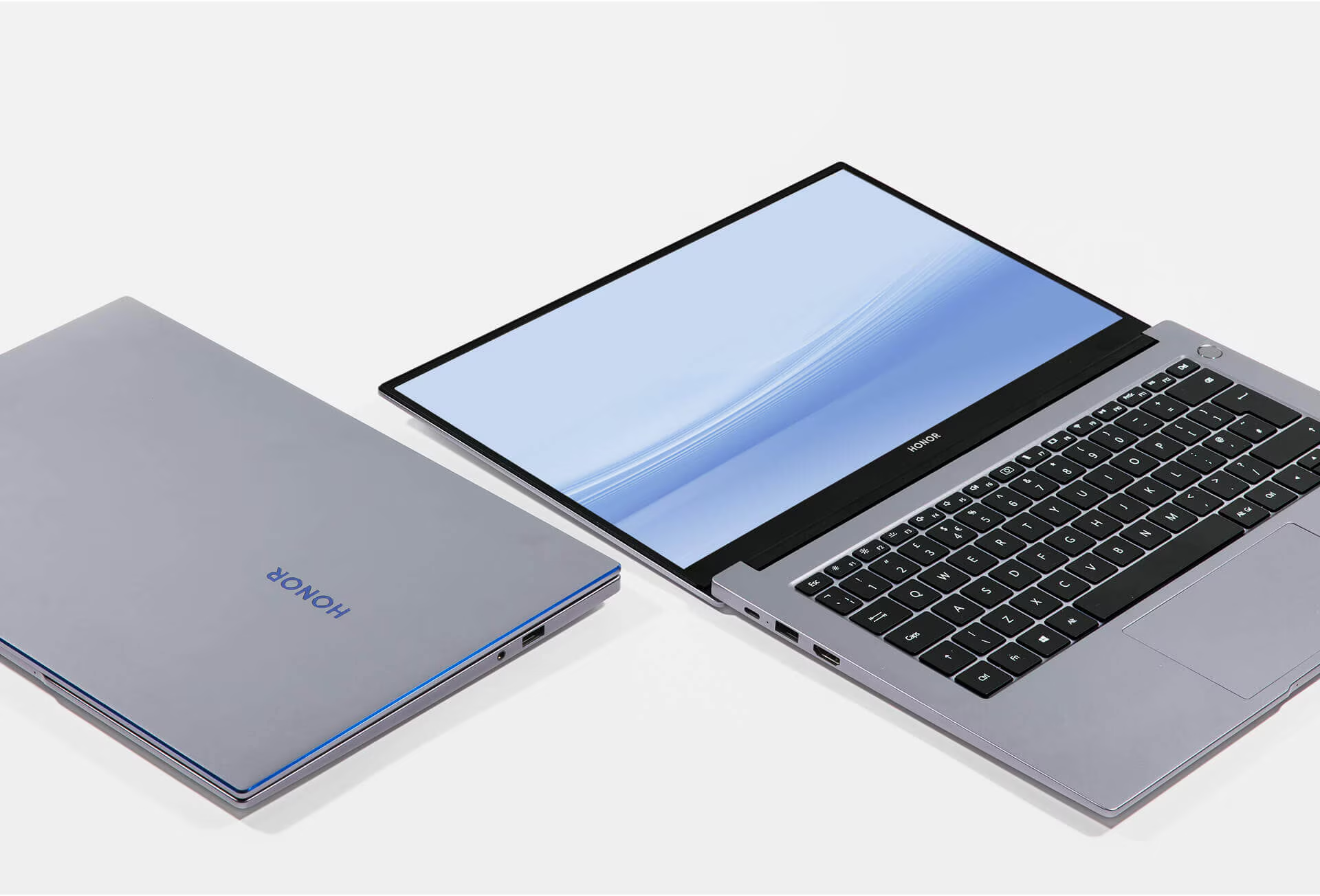Honor MagicBook 14 (2025) vs The Competition: Can It Outsmart the Ultrabook Giants?

The ultrabook market in 2025 is fiercely competitive, with names like Dell, Apple, and HP constantly redefining what slim productivity laptops can achieve.
Enter the Honor MagicBook 14 (2025) — a sleek, value-driven notebook promising flagship efficiency at a lower price. But how does it compare to powerhouse rivals like the Dell XPS 13, MacBook Air M2, and HP Envy x360 14?
This deep-dive examines where Honor’s latest MagicBook leads, lags, and whether it’s the hidden gem of the mid-premium laptop segment.
Story Synopsis
Honor’s MagicBook 14 series has matured rapidly since its debut, evolving from budget-friendly AMD builds to refined, premium-level ultrabooks. The 2025 model brings Intel’s new Core Ultra 5 and 7 processors — or optional AMD Ryzen 7 7840HS variants — delivering balanced power and long battery life in a minimalist aluminum chassis.
While Honor once trailed behind global laptop leaders, the company’s aggressive pricing, improved build quality, and smooth software integration (especially with MagicOS phones) make the new MagicBook 14 a serious challenger.
To see if it truly stands tall, we compared it against the Dell XPS 13, Apple MacBook Air M2, and HP Envy x360 14, four of the most respected names in the thin-and-light category.
What It Means
At its core, the MagicBook 14 aims to hit the productivity sweet spot — blending portability, performance, and affordability. It’s for students, remote professionals, and creators who want solid hardware without the premium tax.
But competing in this field isn’t just about power; it’s about refinement. Apple dominates battery life and ecosystem polish. Dell leads in design and display precision. HP offers flexibility with touch and 2-in-1 form factors. Honor’s challenge is to combine those strengths at a lower price — and with the 2025 MagicBook 14, it’s closer than ever.
How It Works: Specs & Architecture Comparison
Below is a full side-by-side breakdown of the Honor MagicBook 14 (2025) versus its top-tier competitors.
| Feature / Model | Honor MagicBook 14 (2025) | Dell XPS 13 (2024) | MacBook Air M2 (2024) | HP Envy x360 14 (2024) |
|---|---|---|---|---|
| Processor (CPU) | Intel Core Ultra 5 135H (14-core) or AMD Ryzen 7 7840HS | Intel Core Ultra 7 155H (16-core) | Apple M2 (8-core CPU + 10-core GPU) | AMD Ryzen 7 7840U (8-core) |
| Graphics (GPU) | Intel Arc / Radeon 780M | Intel Arc Integrated | Apple GPU (10-core) | Radeon 780M Integrated |
| Display | 14.2″ 2.1K (2160×1440) IPS, 100 % sRGB, 300 nits | 13.4″ FHD+ (1920×1200) or 3K OLED option | 13.6″ Retina (2560×1664), 500 nits True Tone | 14″ OLED (2880×1800), HDR 400 |
| Memory (RAM) | 16 GB LPDDR5 (soldered) | 16 – 32 GB LPDDR5 | 8 – 24 GB Unified Memory | 16 – 32 GB LPDDR5 |
| Storage | 512 GB – 1 TB PCIe 4.0 SSD | 512 GB – 2 TB SSD | 256 GB – 2 TB SSD | 512 GB – 1 TB SSD |
| Battery Life | Up to 12 hours (65 W USB-C fast charging) | Up to 13 hours | Up to 18 hours | Up to 14 hours |
| Weight | 1.54 kg (3.4 lbs) | 1.17 kg (2.6 lbs) | 1.24 kg (2.7 lbs) | 1.4 kg (3.0 lbs) |
| Build & Design | Aluminum unibody, fingerprint reader, pop-up webcam | CNC aluminum, InfinityEdge display, Thunderbolt 4 | Recycled aluminum, MagSafe, fanless | Metal chassis, 2-in-1 hinge, touch/pen input |
| Operating System | Windows 11 Home / Pro | Windows 11 Home / Pro | macOS Sonoma | Windows 11 Home / Pro |
| Connectivity | Wi-Fi 6E, BT 5.3, 2× USB-C, 1× USB-A, HDMI 2.1 | Wi-Fi 7, BT 5.4, 2× Thunderbolt 4 | Wi-Fi 6, BT 5.3, 2× USB-C | Wi-Fi 6E, BT 5.3, 2× USB-C, USB-A, HDMI |
| Notable Features | 65 W GaN fast charger; Magic Link cross-device sync | Edge-to-edge InfinityEdge display; AI mic system | Best battery life; silent operation | OLED touch; convertible design |
| Starting Price (USD) | ~$899 | ~$1,199 | ~$1,099 | ~$999 |
Interpretation
The Honor MagicBook 14 delivers competitive hardware at a lower cost than most rivals. It’s heavier and less premium-feeling than the Dell XPS 13 or MacBook Air but compensates with extra ports, faster charging, and a compelling value proposition.
It easily undercuts Apple’s and Dell’s pricing, while outperforming budget laptops from Asus and Acer. For everyday tasks, the difference in performance is marginal, but the price gap is substantial — making Honor’s ultrabook a top contender for value-focused professionals.
Why It Matters
Laptop buyers today face choice overload, and Honor’s emergence as a credible challenger shakes up a stagnant field.
Its MagicBook 14 offers many flagship features — slim metal design, modern CPUs, fast storage, and good display calibration — at hundreds less than competitors. That democratizes premium computing power for students and creative freelancers who can’t justify a $1,200-plus ultrabook.
However, compromises exist. Battery life lags behind Apple’s MacBook Air M2 by several hours, and the webcam’s under-display positioning remains divisive. But the fundamentals — performance, screen, and design — now rival the best in class.
What’s Next
Honor is expected to expand its MagicBook lineup with OLED displays, AI-powered battery optimization, and improved webcam placement (already tested in the MagicBook Art 14).
Meanwhile, competitors are evolving quickly: Dell’s next-gen XPS is rumored to integrate adaptive AI scheduling, and Apple’s MacBook Air M3 could bring further efficiency gains.
In this landscape, the 2025 MagicBook 14 represents more than just a good laptop — it’s a sign that midrange devices can deliver premium experiences without the premium markup.
Tech Tidbits
-
The MagicBook 14 uses Intel’s Core Ultra series, combining hybrid cores and integrated Arc graphics for improved multitasking and light gaming.
-
Honor Magic Link allows seamless file transfers and screen sharing with Honor smartphones.
-
Earlier models suffered from webcam placement; the 2025 edition moves to a top bezel.
-
Battery endurance can reach 12 hours of mixed use, with a 65W GaN charger that fills 50% in 30 minutes.
-
Dell XPS 13 and HP Envy use advanced vapor chamber cooling — a feature Honor may adopt next.
Publication / Release Details
Title: Honor MagicBook 14 (2025) vs The Competition
Published: October 2025
Based on: Manufacturer data, independent reviews from NotebookCheck, TechRadar, and Android Authority
Focus: Comparison of performance, design, value, and market position
Availability: Global rollout expected Q4 2025 (Europe and Asia first)






